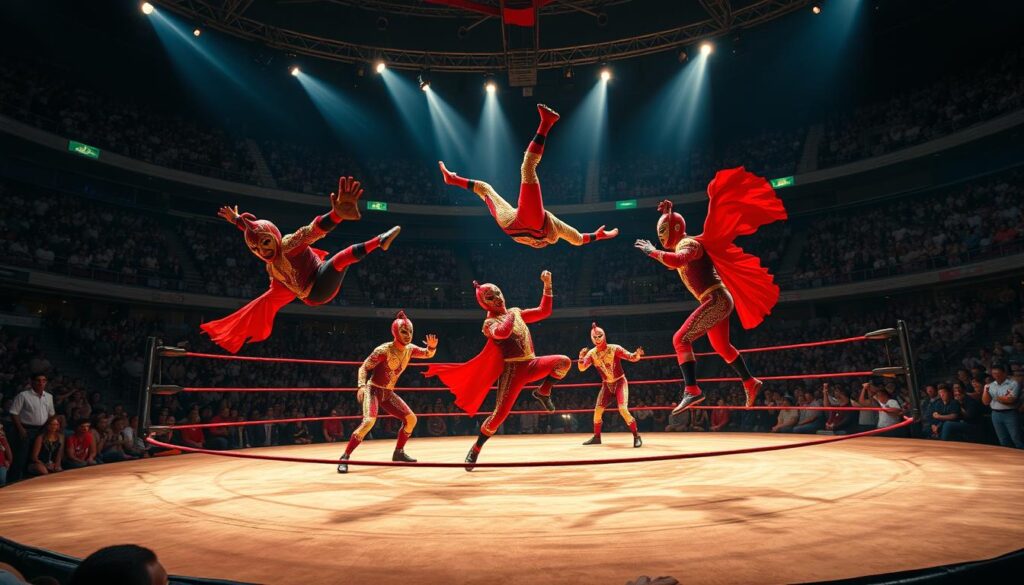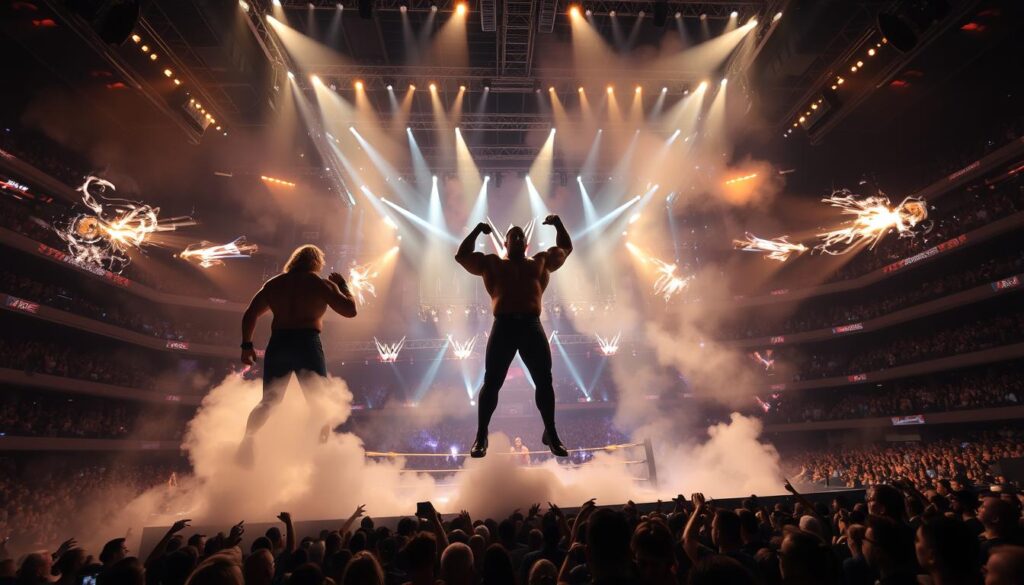Let’s go back in time – literally. Our journey starts with Paleolithic artists in southern France drawing grappling pairs on cave walls 15,000 years ago. These weren’t simple doodles. They were the first “how-to” guides for winning fights at mammoth feasts.
In Egypt’s Beni Hasan tombs (2000 BCE), artists painted wrestlers doing moves that could knock out today’s MMA fighters. The arm drags and hip tosses shown there are more than just art. They are blueprints for ancient athletes, similar to today’s WWE stars, but without the flashy costumes.
The Epic of Gilgamesh is like a combat sports documentary from ancient times. When Gilgamesh wrestled Enkidu for seven days, he wasn’t just showing off. He was proving that grappling mastery made you a legend. This sounds a lot like today’s sports stories, doesn’t it?
Key Threads in Humanity’s Oldest Mat:
- Prehistoric cave art shows wrestling’s role in survival and social bonding
- Egyptian murals document techniques used in modern combat sports
- Mythological texts show grappling as a link between humans and gods
Ancient Roots: When Wrestling Was Philosophy With Elbows
Before cauliflower ears and championship belts, wrestling was humanity’s first TED Talk. It was a brutal yet poetic dialogue between bodies. The Greeks didn’t just invent democracy; they perfected the art of arguing through hip tosses and chokeholds. Let’s look at how ancient grappling history shaped civilizations from Athens to Xi’an.
Imagine MMA meets Plato’s Symposium. Pankration, the original UFC, combined boxing, kicking, and ground fighting. But this wasn’t just bloodsport. Victors were celebrated as philosopher-athletes, with their techniques debated in agora forums like intellectual property disputes. Plato himself said, “A society’s worth is measured by its front headlocks.”
Key features of this proto-grappling system:
- No weight classes (democracy stops at the mat’s edge)
- Chokes allowed, but eye gouging discouraged (ancient “sportsmanship”)
- Victory via submission or unconsciousness (the original “tap out”)
Rome’s Collar Tie Conscription:
While Greeks philosophized, Romans weaponized. Legionnaires trained in luctatio – a pragmatic wrestling style. It emphasized:
| Technique | Military Application | Modern Equivalent |
|---|---|---|
| Arm drags | Disarming opponents | Judo throws |
| Body locks | Shield formation breaches | MMA clinch work |
| Leg trips | Cavalry takedowns | Freestyle doubles |
Centurions created history’s first combatives manual. Think Navy SEALs drilling suplexes before beach landings.
Shuai Jiao’s Demon-Slaying Legacy:
Meantime in China, warriors fought humans and demons. Shuai Jiao (wrestling’s most dramatic origin story) claims the Yellow Emperor developed throws to subdue demons. This 4,000-year-old tradition blended:
- Ceremonial jackets (early singlets)
- Foot sweeps disguised as dance moves
- Moral philosophy (Confucius-approved face-planting)
While Greco-Roman styles banned leg attacks, Shuai Jiao embraced them. This was a cultural fork in wrestling’s evolutionary road.
These amateur styles weren’t just combat systems. They were living arguments about human capability. The original philosophical art of wrestling where every takedown carried existential weight. Next time you see a collar tie, remember: you’re gripping history itself.
Folk Wrestling Traditions Globally
Before WWE, every culture had its own wrestling style. These styles were more than sports; they were ways to solve problems and bring people together. From Persian wrestlers reciting poetry to Scottish clans using chokeholds, folk wrestling shows our love for takedowns is ancient.
Varzesh-e Pahlavani: Where Wrestling Meets Poetry Slam
In Iran, wrestlers lift huge wooden clubs called meels in zurkhane (“house of strength”). It’s like Stone Cold Steve Austin lifting beers, but with ancient mysticism. This tradition combines wrestling with Sufi philosophy, creating a unique athlete-poet.
Competitors recite epic verses from the Shahnameh while wrestling. It’s a true test of multitasking.
Celtic Backhold: The Original No-Floor Challenge
In Scotland, the Backhold style meant no touching the ground with anything but feet. This rule helped avoid disputes over sheep and dowries. It’s why the Highland Games never needed courts.
Standing-Only Rules: Granby Rolls Before Granby
The Celtic rule against ground fighting led to escape techniques. These techniques were later used in catch wrestling. The granby roll in modern wrestling? It might have started with a Scot trying to avoid his mother-in-law’s porridge bets.
| Region | Style | Signature Move | Modern Legacy |
|---|---|---|---|
| Persia | Varzesh-e Pahlavani | Meel Club Swings | Inspired Greco-Roman strength training |
| Scottish Highlands | Backhold | Chest-to-Chest Clinch | Precursor to collar-and-elbow grappling |
| Cornwall | Jacket Wrestling | Lapel Throws | Influenced carnival strongman shows |
Did every village square double as a wrestling ring? Cornwall’s jacket wrestling suggests our ancestors shared grappling secrets. These styles merged in 19th-century carnivals, shaping modern catch wrestling. So, next time you see a lucha libre mask, think of a Persian poet-warrior.
The Emergence of Catch-As-Catch-Can and Pro Wrestling
Imagine Victorian strongmen switching from cauliflower ears to box office hits. The 1830s French circus was more than acrobats; it was where wrestling’s greatest hustle started. When people got bored with real wrestling, carnival workers saw the money in scripted spectacle. This marked the start of wrestling’s shift from sport to show.
Lancashire miners brought catch wrestling to the circus. This tough style was a hit with crowds. The 1908 match between Gotch and Hackenschmidt was huge, like today’s Super Bowl. When Gotch won in 1911, fans didn’t just cheer; they bought his mustache wax, the first viral merch.
This merch boom showed wrestling’s secret: kayfabe. It’s believed to mean “keep fake,” creating wrestling’s first cinematic universe. Fans knew it was staged but played along, like adults keeping Santa alive for kids.
Wrestlers became walking brand extensions. Gotch’s wax and Hackenschmidt’s “strength tonics” were more than products; they were proof of character. This was the start of sports entertainment’s golden rule: Never break the illusion. Even when matches were obvious farces, the show went on, with barkers shouting “EC-Dub!” long before Extreme Championship Wrestling.
Key Styles: Lucha Libre, Puroresu, British, American
What do luchador masks, Japanese MMA hybrids, and British mat technicians have in common? They’re the heart of modern wrestling’s global identity. This mix of styles creates a world where athleticism meets art.
Masked Revolution
Before Iron Man’s helmet or Spider-Man’s webs, lucha libre brought us real-life superheroes. El Santo was more than a wrestler; he was a movie star. His silver mask became a symbol of Mexico, fighting against all sorts of villains.
In Britain, wrestling was all about strategy. The World of Sport era (1965-1985) made wrestling like a chess match. Johnny Saint’s matches were like physics lessons, where every move was calculated.
Strong Style’s Birth
Japan countered with puroresu, where wrestlers were known for their toughness. Antonio Inoki’s 1976 fight against Muhammad Ali was a game-changer. It showed the world that wrestling could be as intense as combat sports.
The 1980s saw the rise of Tiger Mask. Satoru Sayama’s character was a mix of anime and wrestling. It made wrestling popular in places like manga stores and video game arcades.
American promoters took note and wondered: “How can we add excitement?” Their answer would change pop culture forever. But that’s a story for Section 6’s mosh pit.
Fusion and Innovation (ECW, Strong Style)
Imagine combining lucha libre’s acrobatics with the intensity of a Philly brawl. That’s what ECW brought to wrestling, making it like punk rock. It was a bold move against amateur styles and the clean-cut image of corporate wrestling. ECW mixed Japanese strong style’s toughness with Mexican aerial moves, creating a unique blend.
Sabu’s 1995 match against Terry Funk is a prime example. Sabu didn’t just break tables; he turned physics into a performance. Each broken piece of wood added a twist, turning wrestling in pop culture into a raw, intense experience. ECW’s magic lay in making chaos seem deliberate, like a Pollock painting with folding chairs.
In Japan, Strong Style turned wrestling into a dramatic art form. The 1994 match between Misawa and Kawada was a 40-minute masterpiece. Their elbow strikes were like dramatic pauses, adding depth to the match. Kawada’s selling of a tiger suplex showed the tragic fall of a dream, making wrestling a form of psychological warfare.
This fusion has influenced modern wrestling. Today’s wrestlers blend ECW’s daring with Strong Style’s technical skill. They’re not just athletes; they’re cultural artists, mixing global styles for a global audience. With Kota Ibushi’s moonsault, you don’t need superhero movies.
Style’s Impact on Presentation and Narrative
Wrestling is more than just fighting. It’s a show where costumes tell stories. When pyro goes off and the crowd cheers, it’s like watching a myth come to life.
Kayfabe’s Costume Changes
Remember when wrestlers wore simple trunks? Now, their outfits are like superhero costumes. Lucha masks are not just masks; they carry deep cultural meaning.
The NWO’s black and white outfits made fans choose sides. Today, wrestlers wear costumes that tell their whole story. Demon Finn Bálor’s paint and Orange Cassidy’s shorts are more than clothes; they’re part of their character.
Entrance Themes as Character DNA
Stone Cold’s music is like a signal for fans to get ready for action. Jim Johnston’s WWF songs were like psychological attacks. They made you feel something just by listening.
Ric Flair’s theme is like a symphony of pride. The Undertaker’s music is a haunting melody. These songs are like a brand for each wrestler.
| Theme Song | Character Trait Amplified | Crowd Reaction Time |
|---|---|---|
| “Also Sprach Zarathustra” (Ric Flair) | Opulent arrogance | Instant cheers/boos |
| “Gong” (Undertaker) | Supernatural dread | 3-second eerie silence |
| “Break the Walls Down” (Chris Jericho) | Millennial rockstar edge | Immediate sing-along |
Today’s wrestlers carry on this tradition. Becky Lynch’s music is like a Celtic warrior’s call to battle. Roman Reigns’ drums make you feel like you’re in a tribal ceremony.
Wrestling has grown from a carnival act to a multimedia experience. The question is, what story does your favorite wrestler’s music tell? And will you care about it from the first note?
Looking to the Future
What happens when TikTok influencers share lucha libre highlights faster than Marvel drops trailers? Wrestling’s next chapter isn’t just about body slams. It’s a geopolitical Royal Rumble where amateur styles meet influencer culture. Women are rewriting the script entirely.
WWE’s Women’s Evolution didn’t just main-event WrestleMania. It turned Rhea Ripley into Gen Z’s anti-heroine, blending goth aesthetics with suplex diplomacy. Japan’s STARDOM sells out Tokyo Dome shows faster than Taylor Swift tickets. This proves joshi wrestlers aren’t a “diva revolution” footnote but the headline act.
| Style | Key Innovation | Global Influence |
|---|---|---|
| Olympic Freestyle | Gable Steveson’s mat techniques | U.S. college wrestling → WWE contracts |
| Lucha Libre | Masked Republic streaming deals | Latin America → 80+ countries |
| Joshi Puroresu | STARDOM’s cross-promotion tactics | Japanese idols → global merch empires |
But here’s the billion-dollar moonsault: Can AEW’s workrate warriors coexist with WWE’s CGI-laden spectacles? As UFC eats into wrestling’s “reality” market share, the industry responds by hybridizing. Logan Paul’s YouTube subscribers get crash courses in German suplexes, while indie darlings borrow moves from Olympic amateur styles.
The true game-changer? Streaming’s borderless ring. When Mexico’s AAA runs shows in Saudi Arabia and New Japan Pro-Wrestling trends on Twitch, global influence isn’t a buzzword—it’s survival. Wrestling’s third golden age won’t be televised. It’ll be algorithmically optimized, gender-fluid, and fluent in seven languages—including emoji.
Conclusion
For over 5,000 years, wrestling has captivated us. From ancient Egyptian paintings to today’s wrestling shows, our love for it remains strong. It shows our deep connection to both the brutal and the beautiful sides of life.
Today’s wrestling shows like WWE and NJPW carry on a tradition of storytelling through action. They draw from ancient traditions like Lucha Libre’s masks and ECW’s hardcore matches. Each match tells a story, echoing the struggles of our ancestors.
Wrestling feels real because it’s not just about the fake fights. It’s about the genuine emotions and risks taken by the wrestlers. Even with today’s advanced technology, there’s something special about seeing athletes risk their health to entertain us.
So, when someone says wrestling is fake, remind them that theater has always been real. Streaming services won’t change that. Wrestling’s history shows us that we’ll always be drawn to stories told through action and drama.


